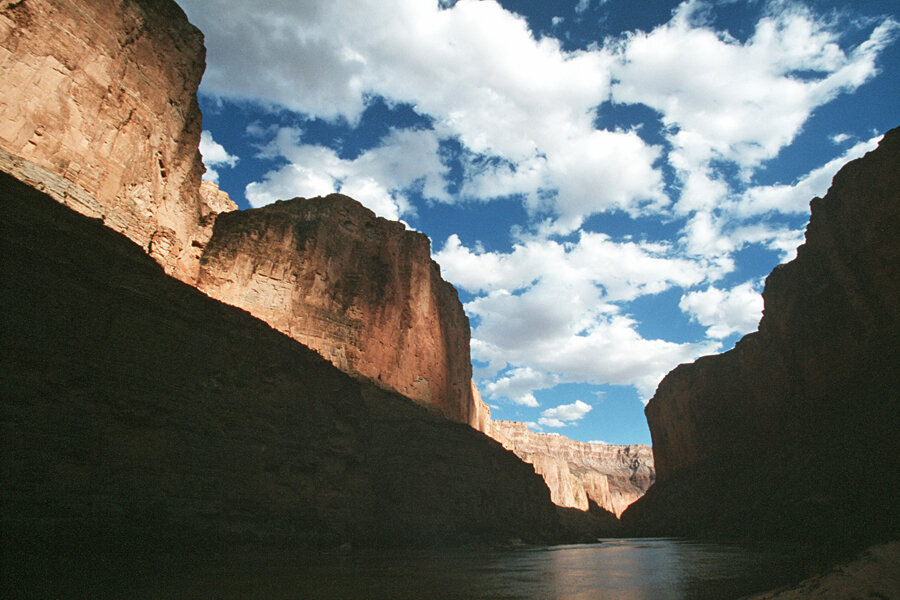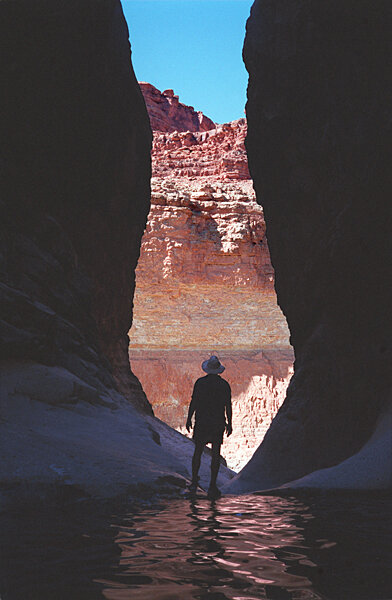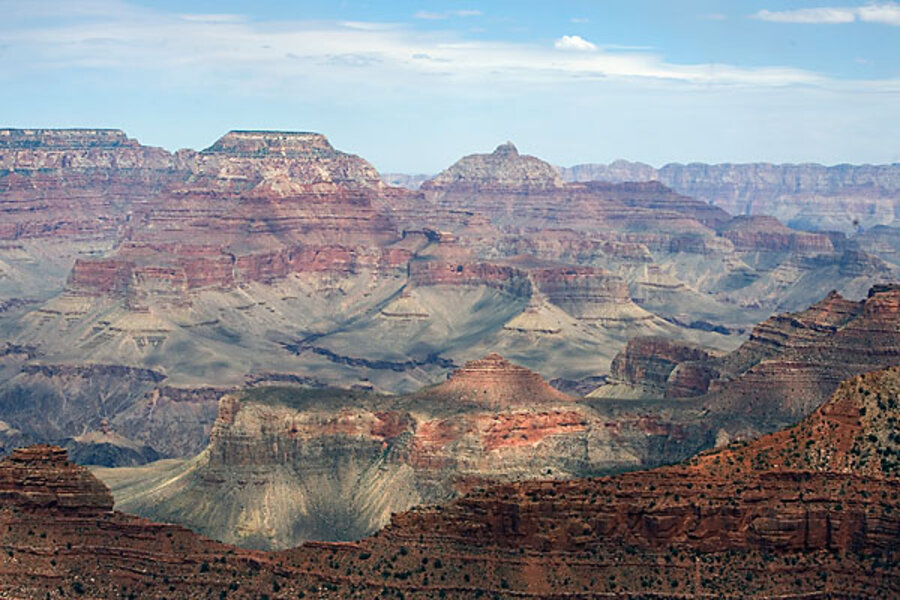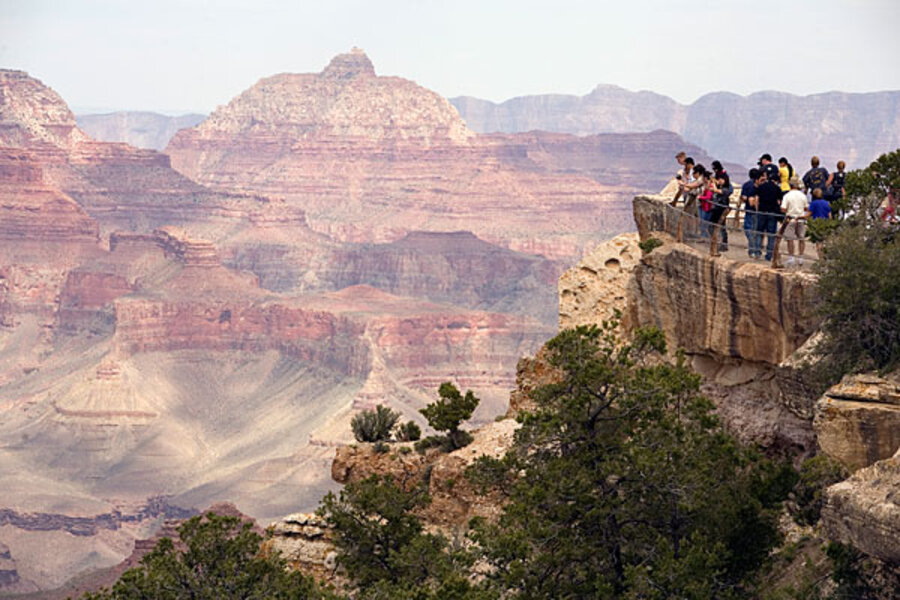How old is the Grand Canyon? You might be surprised.
Loading...
The debate over the age of the Grand Canyon has raged for over 140 years: It's old! It's young! It's really, really old! It's not as old as you think! But now a paper in Nature Geoscience offers a possible compromise: Yes, the Colorado River has been carving the Grand Canyon for only 6 million years, but it is flowing through canyons that date back about 70 million years.
Call it Mother Nature's recycling effort.
Back when dinosaurs were wrapping up their time on Earth, rivers were carving a path through what is now Arizona. Time passed, the rivers dried up, and the canyons stood, dry and empty, for tens of millions of years. Not too far away, another canyon was carved, about 20 million years ago. Then, just 6 million years ago, snowmelt from the Rocky Mountains began seeking a path to the ocean, and the rushing water took advantage of these canyons as it headed west to the Pacific, ultimately becoming the Colorado River.
Though they are still working out some of the details – maybe groundwater, not snowmelt, drove the creation of the Colorado River? Maybe caves played a role? – lead author Karl Karlstrom and his co-authors think they have worked out the bulk of the Grand Canyon's origin story.
"We think that this paper reframes the controversy," says Professor Karlstrom, who literally wrote the book on the Grand Canyon. "I think we've laid to rest one end-member of the 'Old Canyon' model, which is that the Grand Canyon was carved 70 million years ago by rivers other than the Colorado River.... Unfortunately or fortunately, we've also laid the other end-member to rest, which is that the entire canyon has been carved in 5 to 6 million years."
For years, the latter "end-member" – the 'Young Canyon' model – was accepted as fact. Visitors to Grand Canyon National Park will see placards explaining that theory. Then, in 2012, geologists Rebecca Flowers and Ken Farley shocked the community with data showing that at least some of the canyons were carved 70 million years ago.
"The Grand Canyon is one of the most dramatic and iconic features on Earth," says Dr. Flowers. "It automatically raises questions: Why do rivers carve canyons? Canyons of this magnitude? Certainly, it's been longstanding question: What is the history of the Grand Canyon? In the scientific community, it has been hotly debated for a very long time, even though most people outside the scientific community perhaps haven't been aware of that debate. Now we have new techniques, more sophisticated methods that allow us to interrogate different parts of this history."
Apatite for destruction?
Those "sophisticated methods" include looking deep into apatite crystals. Found in the sandstones that occasionally interweave with the limestones making up much of the Grand Canyon walls, apatites change chemically as they cool. Like most rocks, the deeper underground an apatite crystal is, the warmer it is. As the overlying rock is eroded away, the apatite cools off – in ways that scientists can measure, using three thermochronologic tools: Apatite fission track, apatite (U-Th)/He ratios, and 4He/3He ratios.
"Geologists have pieced together bits of the (age) puzzle for decades and decades. The newer thing that's come along is the field of thermochronology," says Karlstrom, a structural geologist with the University of New Mexico. "If we can track the cooling of rocks through time, we can understand the erosion process better and also try and reconstruct past landscapes."
Of the five segments of the Grand Canyon – Marble Canyon, Eastern Grand Canyon, Muav Gorge, Hurricane fault segment, and Westernmost Grand Canyon – Karlstrom argues that only Hurricane was fully carved out before the Colorado River began to flow. Eastern Grand Canyon, he says, is 15 to 25 million years old, but was carved only to about half of its current depth. The other three segments (Marble, Muav, and Westernmost), he argues, were all carved within the last 6 million years.
"I would say 80 percent of the canyon rock volume – of the big hole that we see there now – about 80 percent of that volume has been carved in the last 6 million years," says Karlstrom. "It's just that it made use of these partially carved canyon segments when the river got integrated, 5 to 6 million years ago. So I'm still a proponent – a strong proponent – of the 'Young,' or mostly young Grand Canyon."
Of course, "young" means something different to geologists.
Deep canyon, deep time
"The heartbeat of the Earth is a million years," says Karlstrom. "We're going to use the world 'old' for a 70 million-year-old Grand Canyon and 'young' for a 6 million-year-old Grand Canyon. There's another perspective, geologically, that we have to have: Either one of those hypothesis mean that this is a geologically young canyon, because the rocks that are exposed by erosion in the walls of the Grand Canyon go back 2 billion years – 2 thousand million years. So it's a debate of 70 versus 6, or maybe a little of each, and we can't lose track of the fact that it's a relatively young canyon that's carved into very, very old rocks."
To help visitors understand the scale of geologic history, Karlstrom helped design the Grand Canyon's "Trail of Time" exhibit, which he calls "the world's largest geoscience exhibition at the world's grandest geologic landscape." It's a walkway almost three miles long, where each meter represents one million years of Earth's history.
"The last six steps of that walk has a sign saying, 'The Grand Canyon was carved in the last six million years,' " says Karlstrom. "That exhibit went up in 2010, after 15 years of work. If I had to change the sign now, I'd say, 'The Grand Canyon was mostly carved in the last six million years – in the last six steps of this long walk. Landscapes before the last 70 steps just had nothing to do with the Grand Canyon, but in the last 70 steps, there were some river branches and canyons and paleocanyons and landscapes that led to the last six steps, when the river came through and carved the canyon.' That's our pitch, anyway."
Cowboys and collaborators
Karlstrom's theory incorporates most of Flowers and Farley's apatite data, but they still disagree about the history of the westernmost branch of the Grand Canyon.
"I think our interpretations for the vast majority of the Grand Canyon – everywhere east of the Westernmost Grand Canyon – the incision history is pretty much the same," Flowers told the Monitor. "So he's not disagreeing with our interpretations for the majority of the canyon. And in the westernmost part, our actual data are the same. So at this point I'd say it's unclear why he reaches such a different interpretation of the incision history when the actual hard data – the facts that we're evaluating – are the same.... In the westernmost part of the canyon, I would still argue that the ancient dates that we're seeing are consistent with a much more ancient canyon sitting there that was carved to within a few hundred meters of the modern depth about 70 million years ago."
Karlstrom says he is looking forward to incorporating all three thermochronological techniques in the Westernmost Grand Canyon, in hopes of coming to a scientific consensus. "Science is self-correcting," he says. "There's cowboys, there's collaboration, it moves forward in fits and starts, but the last few years have seen a great advance in the community addressing the interesting questions about how this iconic landscape was formed.
"It's really one of the most beautiful landscapes on earth, and one of the best geologic laboratories for training students, and it captures the interest of the public, so it's a terrific place for research. It's also a terrific place to convey to the public how scientists make progress on research."









